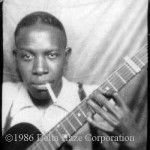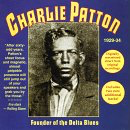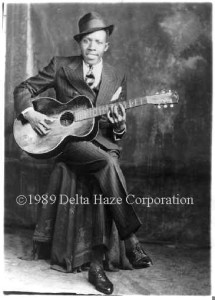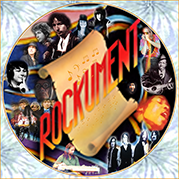The Country “Hillbilly” Blues Roots of Rock Music
Rock music came together from many sources and influences, including all forms of the blues. The first “rock ‘n’ roll record” (according to a interesting book, What Was the First Rock ‘n’ Roll Record? by Jim Dawson and Steven Propes) is “Rocket 88” by Jackie Brenston with Ike Turner (1951), mainly because it introduced that fuzz tone and distortion sound we take for granted in rock today.
But there are many reasonable alternatives, and one could fill several days of nonstop music in an attempt to cover the territory. Many of these alternatives are blues songs from the Chicago Blues music (introducing the electric guitar) of 1940-60.

 If you trace back the origins of these blues songs and stylings, you find the country blues of Robert Johnson, Son House, Blind Lemon Jefferson, and Charley Patton, mixed with some hillbilly music termed “folk” by today’s standards, including Elizabeth Cotten, the Carter Family, Clarence Ashley, and Cannon’s Jug Stompers. Rock music derives its raw spirit of rebellion and lusty sex from the country blues sound, which gave birth to the Chicago blues, rhythm and blues, and rock ‘n’ roll.
If you trace back the origins of these blues songs and stylings, you find the country blues of Robert Johnson, Son House, Blind Lemon Jefferson, and Charley Patton, mixed with some hillbilly music termed “folk” by today’s standards, including Elizabeth Cotten, the Carter Family, Clarence Ashley, and Cannon’s Jug Stompers. Rock music derives its raw spirit of rebellion and lusty sex from the country blues sound, which gave birth to the Chicago blues, rhythm and blues, and rock ‘n’ roll.
I’m interested in the way music evolved from that period to today. This playlist demonstrates how some of these early songs were interpreted in rock from the 1960s to the 1990s.
“Shake That Thing” by Papa Charlie Jackson (Traditional)
A native of either New Orleans or somewhere else in the Mississippi Delta (very little is known about him), Papa Charlie Jackson was the first commercially successful male blues singer to appear on records, and the first to record a form of the blues that deviated from the orchestrated popular blues of Mamie Smith and Bessie Smith during 1920-26. He recorded “race” records of blues standards including “I’m Alabama Bound” (later recorded by the Charlatans). He moved up to Chicago from the Delta, way ahead of the bluesmen that would come later, and established his reputation in clubs. This is from his first recordings for Paramount in 1924. It is clearly one of the ancestors of all those “Diddy Wah Diddy” songs.
“Spoonful (a.k.a. A Spoonful Blues)” by Charley Patton (Traditional)
This song is based on an earlier song by Papa Charlie Jackson called “All I Want is a Spoonful”.
Patton, from Edwards MI, toured the Deep South from 1921-23, influencing a number of young bluesmen including Robert Johnson, John Lee Hooker, Howlin’ Wolf, and Willie Dixon, who wrote the modern blues song “Spoonful” (first played by Howlin’ Wolf, and eventually by Cream).
Patton would play his guitar behind his back and between his legs like a vaudeville act, way before Chuck Berry and Jimi Hendrix would do the same. He recorded songs for Paramount in 1929. You can hear the origin of the familiar “Spoonful” riff, set in an arrangement that is more upbeat than the latter-day “Spoonful” that Cream covered.
“Match Box Blues” by Blind Lemon Jefferson (Blind Lemon Jefferson)
Blind Lemon Jefferson may be the most well-known of the ancient bluesmen. Born in Texas, Jefferson’s fame as a blues singer increased in the early 1920s, and he started recorded his blues in 1925 for Paramount in Chicago. This song is from a session in 1927, released on the Okeh label. One night in Dec. 1929, he left the studio and was found dead the next morning, his frozen body lying in the street with his guitar next to him.
“Matchbox” by Carl Perkins (Blind Lemon Jefferson)
Carl Perkins arranged the Blind Lemon Jefferson song “Match Box Blues” (taught to him by his father) into his own “Matchbox” with somewhat different lyrics. Carl Perkins was a contemporary of Elvis at Sun Records and an inspiration for bands that played rockabilly songs, such as the Beatles. Perkins was injured in a car accident and lost his momentum just as Elvis was conquering the pop charts.
Many blues songs found there way into “rockabilly” rock ‘n’ roll. Check out this video of Eddie Cochran doing “C’mon Everybody”:
“That Black Snake Moan” by Blind Lemon Jefferson (Blind Lemon Jefferson)
Like many other singers, Jefferson sang many types of songs for popular audiences, including moans, breakdowns, prison songs, gospel songs, popular tunes of the day. But his own blues centered around the black snake motif (look out Jim Morrison). He does not accompany himself on guitar while singing, but uses it to answer each vocal line, and he suspends the beat for the verse. You can hear him sing “That’s all right, mama” and “Any way you do” in a slow tempo. These lyrics would inspire Arthur Crudup to write perhaps the first rock ‘n’ roll song, “That’s All Right,” which was covered by Elvis Presley and Carl Perkins, providing a direct link from Blind Lemon to rock ‘n’ roll.
“That’s All Right” by Arthur “Big Boy” Crudup (Crudup)
The lyrics of Blind Lemon Jefferson’s “That Black Snake Moan” inspired Arthur Crudup to write “That’s All Right,” which was covered by Elvis Presley and Carl Perkins. Arthur Crudup was well known in Memphis before the age of Elvis, and Sun Records’ Sam Phillips was inspired by Crudup’s live performance to go out and find a white boy who could sing with the same feeling.
“Cross Road Blues” and “Milkcow Calf’s Blues” by Robert Johnson (Johnson)
 Robert Johnson, king of the Delta blues, was the main inspiration for a generation of country blues and rock. Johnson was cited as the main influence by Eric Clapton, Keith Richards, and many others. Born in 1911 in the Mississippi Delta region, Johnson absorbed the music and live performances of Leroy Carr (“How Long, How Long Blues”), Charley Patton, and Son House. This song, recorded in Nov. 1936, fueled a long-standing myth about Johnson — that he made a deal with the devil in order to gain newfound musical talent. He went away for some time, local bluesmen said, and when he returned, he was so much better they could not believe it. The song has been covered by many blues and rock artists, with Cream taking it to a magnificently lofty peak of a jamming experience.
Robert Johnson, king of the Delta blues, was the main inspiration for a generation of country blues and rock. Johnson was cited as the main influence by Eric Clapton, Keith Richards, and many others. Born in 1911 in the Mississippi Delta region, Johnson absorbed the music and live performances of Leroy Carr (“How Long, How Long Blues”), Charley Patton, and Son House. This song, recorded in Nov. 1936, fueled a long-standing myth about Johnson — that he made a deal with the devil in order to gain newfound musical talent. He went away for some time, local bluesmen said, and when he returned, he was so much better they could not believe it. The song has been covered by many blues and rock artists, with Cream taking it to a magnificently lofty peak of a jamming experience.
Robert Johnson reigned during the late 1920s and early 1930s country blues scene in the Delta, playing with blues greats Sonny Boy Williamson II, Robert Nighthawk, Elmore James, Honeyboy Edwards, Howlin’ Wolf, and Johnny Shines. He developed a taste for all kinds of “bad” behavior, including booze, smoke, gambling, and stealing women from their men. He traveled incessantly and performed as far from the Delta as St. Louis, Chicago, Detroit, and New York City. He played his last gig in Aug. 1938, when he was killed by an angry husband.
“Milkcow Blues Boogie” by Elvis Presley (Kokomo Arnold)
Elvis Presley starts the song in the traditional slow blues style, then stops. “Hold it fellas. It don’t move,” he says to the other musicians. “Let’s get real real gone for a change!” Here, in a vocal outtake, is the transition point from blues to rock ‘n’ roll. Kokomo Arnold wrote this song, which Robert Johnson arranged into one of his own. Elvis Presley recorded this at Sun Records Studios in Dec. 1954, with Scotty Moore on lead guitar and Bill Black on bass.
Check out the Original Unofficial Elvis Home Page, which has links to thousands of Elvis sightings on the Web.
“Bull Doze Blues” by Henry Thomas (Henry Thomas)
Henry Thomas, a.k.a. Ragtime Texas, born in 1874, played guitar in a finger-picking and strumming style, and on this song played the quills (pan pipes), a reed instrument with roots in African music, which was mostly replaced by harmonicas by the 1920s. Thomas performed at the Columbian Exposition of 1893 and the St. Louis World’s Fair of 1904, and recorded his songs in 1927 in Chicago for Vocalion Records. After two years of performances and studio sessions, he vanished without leaving a trace.
“Going Up the Country” by Canned Heat (Wilson)
This song was used as the opening tune for the film Woodstock. Canned Heat was formed by Bob “The Bear” Hite and Al “Blind Owl” Wilson, who sings lead vocals on this song, which he derived from “Bull Doze Blues” by Henry Thomas, substituting a flute for the quills.
Check out the Official Canned Heat page.
“That’s No Way to Get Along” by Robert Wilkins and “Prodigal Son” by the Rolling Stones (Jagger/Richards)
 The Rolling Stones wrote “Prodigal Son” based entirely on “That’s No Way to Get Along” by Robert Wilkins, a Memphis singer in the 1920-30s who started (and ended) as a gospel singer, although he could play excellent blues guitar. The Stones were at that time, 1968, more of a quintet than a band fronted by Mick Jagger (vocals), with Keith Richards on guitar, Brian Jones on guitar and harmonica (and exotic instruments such as sitar and dobro), and Bill Wyman (bass) and Charlie Watts (drums) forming the most solid rhythm section in rock.
The Rolling Stones wrote “Prodigal Son” based entirely on “That’s No Way to Get Along” by Robert Wilkins, a Memphis singer in the 1920-30s who started (and ended) as a gospel singer, although he could play excellent blues guitar. The Stones were at that time, 1968, more of a quintet than a band fronted by Mick Jagger (vocals), with Keith Richards on guitar, Brian Jones on guitar and harmonica (and exotic instruments such as sitar and dobro), and Bill Wyman (bass) and Charlie Watts (drums) forming the most solid rhythm section in rock.
“Old Dog Blue” by Jim Jackson (Traditional) and “Old Blue” by the Byrds (Jim Jackson)
Jim Jackson was a medicine show performer, street singer, and jug band musician who played with Gus Cannon and Furry Lewis in and around Memphis in the 1920s. He recorded this in 1928, and it has been covered by bluesmen (Sonny Terry, Furry Lewis), folk artists (Joan Baez, Pete Seeger, Cisco Houston), and rock groups (the Byrds, J.J. Cale). “Old Blue, he died like a man / Now he’s treeing possum in the Promised Land.”
The Byrds had gone through some changes by the time they’d recorded this song. 12-string guitarist and lead singer Jim McGuinn had renamed himself Roger (in accordance with his newfound Subud faith), Chris Hillman on bass and mandolin had led the group into country and western music (with help from friend Gram Parsons) only to leave the band and be replaced by John York, Gene Parsons had replaced Michael Clarke on drums, and Clarence White and moved to the forefront on lead, slide, and pedal steel guitar.
“Minglewood Blues” by Cannon’s Jug Stompers with Noah Lewis (Noah Lewis)
Cannon’s Jug Stompers were a well-known jug and skiffle group in Memphis from 1908-1913. Jug band music started in Louisville, KY, with the Louisville Jug Band but had a greater impact in Memphis. Years later, in 1928, they recorded several songs including this one. Gus Cannon could play many instruments but specialized in banjo and jug. Noah Lewis played harmonica and was the best showman of the group — he could play two harmonicas at once, through mouth and nose. Ashley Thompson sang and played guitar. Minglewood was a lumber camp a few miles east of the Mississippi River near Dyersburg, TN, and Noah Lewis had worked there. He recorded it later as “New Minglewood Blues” by the Noah Lewis Jug Band. The Grateful Dead covered Noah Lewis’ “Viola Lee Blues” and the Jug Stomper’s “Big Railroad Blues” and arranged a new version of this song called “New New Minglewood Blues” (next).
“New New Minglewood Blues” by the Grateful Dead
A live version from April 1971 at the Fillmore East, NYC (2nd set). The Grateful Dead at this time were Jerry Garcia (guitar and vocals), Bob Weir (guitar and vocals), Phil Lesh (bass), Bill Kreutzmann (drums), and Ron “Pigpen” McKernan (organ). This version cooks, especially Phil’s bass, and the interplay of Jerry and Bob’s guitars is as good as it gets.
Check out Rockument’s History of the Grateful Dead, Rockument’s Haight-Ashbury page, and the Official Grateful Dead page.
“99 Year Blues” by Julius Daniels and “99 Year Blues” by Hot Tuna (Julius Daniels/Torrence)
Julius Daniels came from Denmark, SC and recorded this song in Atlanta in 1927. He was one of the first southeastern bluesmen to make records. A version of this song was adapted to become “Viola Lee Blues” by Cannon’s Jug Stompers, covered by the Grateful Dead. This song was covered by Hot Tuna and Jim Kweskin.
Hot Tuna formed as Jefferson Airplane was crashing in the early 1970s, featuring guitarist Jorma Kaukonen and bassist Jack Casady, with Papa John Creach on violin, Sammy Piazza on drums, and Will Scarlet on harmonica. An impromptu jam session at the Chateau Liberte in the Santa Cruz Mountains in April, 1971, led to the formation of “Hot Shit” as they first called themselves (an interim name was supposedly “Hot Fuckin’ Tuna”).
“Nobody’s Fault But Mine” by Jimmy Page & Robert Plant (Blind Willie Johnson)
Blind Willie Johnson was a slide guitar player during the 1920-30s. This version features Led Zeppelin founders Robert Plant (vocals), Jimmy Page (guitars & mandolin), Charlie Jones (bass & percussion), Michael Lee (drums & percussion), Porl Thompson (guitar & banjo), Jim Sutherland (mandolin & bodhran), Nigel Eaton (hurdy gurdy), and Ed Shearmur (Hammond organ).
“Where Did You Sleep Last Night (In the Pines)” by Nirvana (Leadbelly a.k.a. Huddie Ledbetter)
Kurt Cobain (guitar and vocals), Krist Novoselic (bass), Dave Grohl (drums), Pat Smear (guitar), Lori Goldston (cello). This song, written as “In the Pines” by blues anthologist Leadbelly (a.k.a. Huddie Ledbetter) was part of an MTV special Unplugged session, and one of Cobain’s last performances before he died.
For the songs in my playlist, see below.
Overall Copyright (c) 1996-2018 by Tony Bove (for Rockument.com). Individual art, music, and video clips are copyrighted by their respective owners.



